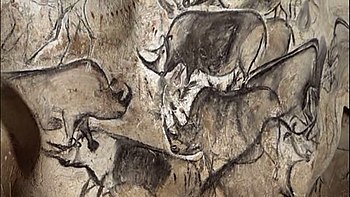Ritual and magic
 |
| image: Wikipedia Tribal artists today often make "X-ray" drawings rather like those of early men, for they also believe that by picturing the vital organs of a human or an animal, they may gain magical control over its life or death. |
If we visualize prehistoric people conducting rituals as they painted on the walls of caves, we find it difficult to associate these practices with anything that we or our artists do today. The relations are actually stronger than we could possibly imagine. We saw in Blog 1, that magic and ritual are two of the main elements of prehistoric art. Both these elements can be found in the arts of our own century, in one form or another.
While magic in our highly industrialized societies has little relation with the arts, it still provides the main function for the arts among the modern primitive peoples. The Sepi in New Guinea, the Bakuba in Congo, the various tribes of the Amazonian jungle, the Aboriginal peoples of Australia are only a few hundred indigenous peoples who practice the mystical art of dance, music, theater, sculpture or drawing. Take the Australian Aboriginals, for example, many of whom still have little contact with the outside world. They live by hunting and gathering food, without stationary dwellings or domestic animals.
In Aboriginal art, one common theme is that of so-called Wondjina figures. Vaguely human in form, with eye and nose blobs, but never a hint that they are mouths-these figures are constantly drawn and repainted. What is the reason? The Aborigines claim "To bring rain," since they think the rain is the most sought after blessing in Australian parched areas only by painting the Wondjina can make the rainfall. And why don't the mouths of Wondjina? Because if they did, the rain would go up and cause flooding. The reasoning goes.
 |
| Wolf swallowing a human figure ( Kwakiutl; western Canada ) |
In 20th century arts, Magic, therefore, persists mainly among primitive peoples as a reason to make art objects. But in all arts in any kind of culture, the other dimension of prehistoric art-ritual-is found. We will address in some chapters of this BLOG series how different forms of art are defined by the practices of one kind or another. To take a few examples at random: Dionysiac practices in Greece gave impetus to the production of the drama *; kabuki theater conventions in Japan can be traced back to their roots in Japanese religious dances *; many religious rituals more or less prescribe the shape of the building in which they are performed; public events such as processions and carnivals have put a certain form on the script.
The ritual has played a major part in the lives of people and in their arts, even in modern times. Religious rites, state processions, and formal events, traditional parades, political rallies, sports meetings, carnival events–each of these includes a ritual of some kind, and each ritual, in effect, requires some kind of art. People make masks and sculptures for carnivals and rallies; they decorate halls with flags, colored streamers, balloons, and so on for political and other conventions; and composers, painters, sculptors, and other artists are commissioned to create works particularly to mark the event for many state occasions.
| At the Shrovetide carnival in Binche, Belgium, an ancient ritual, of unknown origin, is still respected. The men who wear these feathered headdresses are forbidden tradition to leave the town or to dance at any other time of year. |
Ritual, though, was a big boost to the arts now, just as it was to our forebears in the cave-men. But it is often an external spur; that is, for social or religious reasons, traditions that require art products that do not adhere to the artist's own personal beliefs. Let's look now at the demands that emerge from within the artist: the inner force we call imagination
.


ConversionConversion EmoticonEmoticon